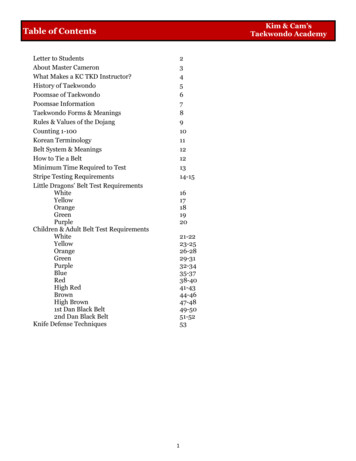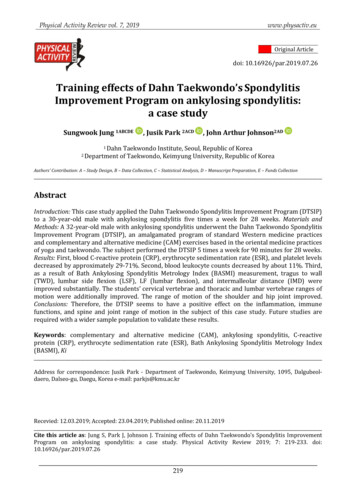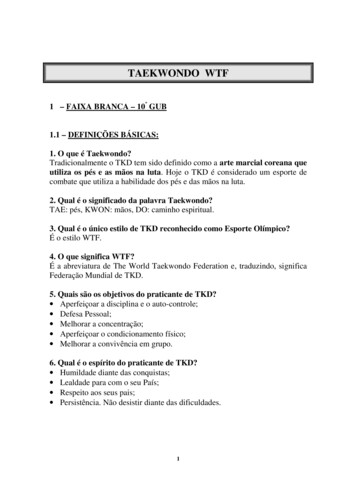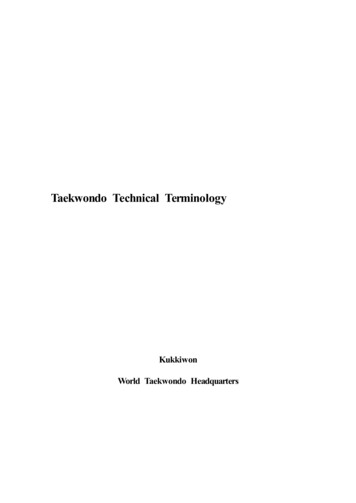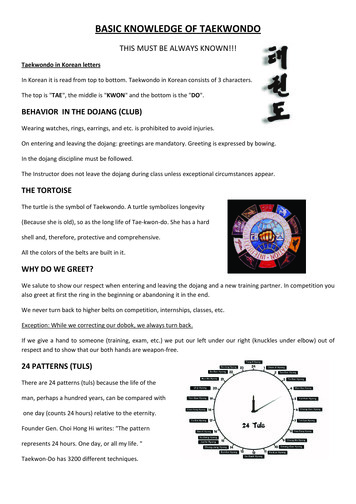
Transcription
Journal of Human Sport and ExerciseE-ISSN: 1988-5202jhse@ua.esUniversidad de AlicanteEspañaMAILAPALLI, DAMODHARA R.; BENTON, JOHN; WOODWARD, THOMAS W.Biomechanics of the Taekwondo Axe Kick: a reviewJournal of Human Sport and Exercise, vol. 10, núm. 1, 2015, pp. 141-149Universidad de AlicanteAlicante, EspañaAvailable in: http://www.redalyc.org/articulo.oa?id 301042304013How to citeComplete issueMore information about this articleJournal's homepage in redalyc.orgScientific Information SystemNetwork of Scientific Journals from Latin America, the Caribbean, Spain and PortugalNon-profit academic project, developed under the open access initiative
Original ArticleBiomechanics of the Taekwondo Axe Kick: areviewDAMODHARA R. MAILAPALLI 11 Agricultural and Food Engineering, JOHN BENTON 2, THOMAS W. WOODWARD 3Department, Indian Institute of Technology- Kharagpur, West Bengal, India2 Epic Systems Corporation 1979 Milky Way, Verona, WI 53593, United States3 Dean Medical Center Urgent Care, Madison, Wis; Assistant Clinical Professor of Family Medicine, University ofWisconsin Department of Family Medicine, Madison, WisconsinABSTRACTMailapalli, D.M., Benton, J., & Woodward, T.W. (2015). Biomechanics of the Taekwondo Axe Kick: AReview. J. Hum. Sport Exerc., 10(1), pp.141-149. The axe kick in Taekwondo has been observed to be ahighly effective offensive and defensive technique. Its purpose is to attack the opponent’s head, collarboneor chest with a powerful downward force. However, few researchers have studied the biomechanics of thiskicking technique. The modified competition rules of World Taekwondo Federation (WTF) on the number ofpoints to the head resulted increase in the number of kicks to the head by athletes using the axe kick.Therefore it is important to know the biomechanical principles of the axe kick for executing the kickeffectively with minimum injury to the opponent’s head, collarbone or chest and for scoring maximumnumber of points in a competition. The main purpose of this article is to present a general description,variations and biomechanics of the Taekwondo axe kick. Key words: TAEKWONDO, AXE KICK,BIOMECHANICS, SAFETY1Corresponding author. Indian Institute of Technology- Kharagpur, Kharagpur- 721302, West Bengal, IndiaEmail: mailapalli@agfe.iitkgp.ernet.inSubmitted for publication January 2015Accepted for publication July 2015JOURNAL OF HUMAN SPORT & EXERCISE ISSN 1988-5202 Faculty of Education. University of Alicantedoi:10.14198/jhse.2015.101.12VOLUME 10 ISSUE 1 2015 141
Mailapalli et al. / Biomechanics of the Taekwondo Axe KickJOURNAL OF HUMAN SPORT & EXERCISEINTRODUCTIONTaekwondo is an ancient art of unarmed combat that includes kicking, punching and way of life. The name‘Taekwondo’ is derived from the Korean words, ‘Tae’ meaning foot, ‘kwon’ meaning fist, and ‘do’ meaningthe way of. So, literally ‘Taekwondo’ means ‘the way of foot and fist’. The name ‘Taekwondo’ was coined in1955 while the arts’ Korean roots began in 2,300 BC. The physical training through kicking and punching iswhat makes Taekwondo unique among other styles of martial arts and the way of life through practicing thetenants of Taekwondo: courtesy, integrity, perseverance, self-control and indomitable spirit. Currently,Taekwondo is widely practiced by 70 million people in 190 countries (Kim, 2009). Martial arts theories tendto be heavily rooted in tradition, and as such have not been biomechanically analyzed to the same degreeas more modern sports such as swimming, gymnastics, and cycling (Pieter, 1994). Choi (1988), states thatTaekwondo techniques are based on the laws of physics and propose the "theory of power" as a basis forideal technique. The first attempts made at delivering a scientific biomechanical description of the martialarts techniques began in the 1960s.Kicks in Taekwondo can be grouped as swing, thrust and combined kicks based on their kinematiccharacteristics of kicking (Kim & Hinrichs, 2006).The swing kicks (e.g. front kick, axe kick),which attempt tohit the front of an opponent in a straight movement, the thrust kicks (e.g. side kick) are performed byrotating the body towards the side of the opponent (front of the opponent faces side of the attacker) withbody rotation directed to the side of the opponent, the combined kicks are performed with both thrust andswing motion(e.g. hook kick). The swing kick is used to maximize the speed of the foot at impact. Thethrust kick is used to generate large forces at impact. The combined kick is used to generate both highspeed and large forces. Swing kicks have highest speed (13.5 meters/second [m/s]) followed by combinedand thrust kicks (Kim & Hinrichs, 2006).In another study, Bercades & Pieter (2006) grouped the Taekwondo kicks as linear, spinning and circular.The linear kicks are simplest in terms of biomechanical efficiency analysis. Studies on linear kicks haveincluded front snap kick and front pushing kick (Ahn, 1985; Hwang, 1987; Wasik, 2012). The spinning andcircular kicks include roundhouse, spinning hook and spinning back kick (Hwang, 1985; Wholin, 1989;Serina and Lieu, 1991; Pieter & Pieter, 1995; Boey & Xie, 2005). The biomechanics of some of theTaekwondo kicks is presented in Table 1.Table 1. Some of the taekwondo kicks and their execution performanceTaekwondo kick142Execution time, sReferenceFront kickTurning(round) kickPeak linearvelocity, m/s12 – 1413– 160.250.74Roundhouse kick19-26.30.30 -0.65Side kickJumping back kick5.2-6.99.260.7-0.840.9Wasik, 2012Pearson, 1997Serina & Lieu, 1991Falco et al. 2011Kong et al. 2000Pieter & Hiejmans, 2003Hermann et al. 2008Pieter & Pieter (1995)Qian et al. 2010 2015 ISSUE 1 VOLUME 10 2015 University of Alicante
Mailapalli et al. / Biomechanics of the Taekwondo Axe KickJOURNAL OF HUMAN SPORT & EXERCISEThe front kick is characterized by a proximal to distal sequential motion with a fast unloaded movement tomaximize kick foot velocity. The peak linear velocity of the foot has been observed within the range of 1214 m/s and the total execution time for this kick is 0.25 s (Wasik, 2012). The turning (round) kick employs amotor control pattern similar to the front kick, but uses additional body rotations to produce great velocity,with a cost of twice the execution time (Table 1). The roundhouse kick is similar to the turning kick (fullturning/round kick) in which the striking surface is the top of the foot. The roundhouse kick constituted 50%of all kicks and contributed 89% of all points in competition (Lee, 1998). This could be due to its greaterpeak linear velocity and lower execution time compared to turning kick. Side kick generates a peak velocity(5.65 m/s) at the length of the leg equal to 82% of the maximum length of the fully extended leg (Wasik,2011a, b). These kicks are more frequently used by the athletes during the tournaments. In order to makeTaekwondo sports fairer and more interesting to watch World Taekwondo Federation (WTF) has modifiedcompetition rules and increased the number of points to the head to three (Han, 2012). This resultedincrease in the number of kicks to the head using the head kicks such as axe kick.Taekwondo axe kick has not been biomechanically studied by many researchers. The axe kick can becharacterized as a whip-like kicking movement during leg lift and an axe-like movement during thedownward drive of the heel or the ball of the foot. The axe kick is most useful when an opponent is open inthe upper body region. Koh & Watkinson (1999) concluded that about 51.4% head blows were by the axekick followed by roundhouse kick (25.7%).The challenge in studying the axe kick is that there is readilyavailable technology to study other kicks, and devising tools to measure axe kick efficiency is more difficult(Bercades & Pieter, 2006; Yu et al., 2012).TAEKWONDO AXE KICKTo execute the axe kick, the fighter brings up his/her kicking leg in a linear/circular motion, and at the peakheight, brings the heel or ball of the foot straight down (like a downward movement of an axe) (Figure 1)upon the opponent’s head, shoulder or chest. Another use for the axe kick is to stop an incoming attack.The fighter can target an axe kick against the supporting thigh of an opponent in the initial stages of a kick.Figure 1. Axe kick execution during power loadThe axe kick is executed in four stages and Yu et al., (2012) demonstrated graphically as shown in Figure2. Stage one, the Decoy, is optional and meant only to confuse the opponent with regards to which leg isVOLUME 10 ISSUE 1 2015 143
Mailapalli et al. / Biomechanics of the Taekwondo Axe KickJOURNAL OF HUMAN SPORT & EXERCISEthe kicking leg and, in turn, create an opening to target. The fighter executes a rapid stance change,followed immediately by the next stage: The Power Load. In this second stage, the fighter raises the kickingleg in a slight medial circular motion, building power for the ensuing kick by pre-lengthening the kickingmuscles. The velocity of the upward motion, as well as the height of the kicking heel will determine theforce of stage three: The Drive. Here, the fighter positions the heel of the kicking foot directly above thetarget area as the heel reaches peak height. The circular motion is stopped and all the energy derived fromthe Power Load is transferred to the Drive downward into the opponent. Finally, stage four, the Landing andStabilization, returns the fighter to a stable stance so further techniques can be performed.Figure 2. Different stages in the axe kickVARIATIONS IN THE AXE KICKThe sequential movements during the axe kick include the knee-raising in an upward in-to-out or out-to-inarc motion. Another variation to this kick involves the simple raising of the leg straight up and down in frontof the body (Figure 3), where the leg is extended above the target and pulled down onto the target.Because the axe kick motion requires the kicking foot to be raised higher than the intended target, theangle created at the hip joint is found to require a substantially large range of motion, and the action cangenerate more power.Figure 3. Demonstration of Taekwondo axe kick; a) Classical axe kick and b) Modified axe kick144 2015 ISSUE 1 VOLUME 10 2015 University of Alicante
Mailapalli et al. / Biomechanics of the Taekwondo Axe KickJOURNAL OF HUMAN SPORT & EXERCISEThe modified version would entail the consecutive segmental extension of the hip and flexion of the kneeon the downward phase of the axe kick (see figure 3b) instead of simply lowering the extended leg as isdone in the classical version of the kick. The chamber for the modified axe kick is same as a front kick inthe beginning and then it snaps like a whip. The bent-leg start in modified axe kick is important incompetition as it prevents the opponent from being able to read what kind of kick is thrown at him until itwhips. It would also be recommended to minimize injuries in competition and at the same time score points(Bercades & Pieter, 2006).BIOMECHANICS OF THE AXE KICKBiomechanics is one of the sub disciplines of kinesiology and by definition it is the study of the applicationof mechanics to biological systems such as human systems. The Biomechanics performance-related areasinclude measurement and motor control of human locomotion, sports, clinics and rehabilitation,orthopedics, among others.The biomechanical factors instrumental to the success and effectiveness of an axe kick are based on thethree aspects of the kick: 1) the maximum target height, 2) the inertia of the kicking leg and 3) the speed ofthe kicking foot. The height at which an athlete can make an attack is determined by the anthropometry ofthe fighter (e.g. body height and leg length) and the flexibility of the fighter. For an axe kick to be effective,all movements of the kicking leg need to have minimal execution time. Thus the dynamic posture /kinematics of the kick should minimize the moment of inertia of the kicking leg during the power load phase.The power of the axe kick is directly determined by the speed of the kicking foot, as it drives downwardtoward its target. Thus the degree of extension of the kicking leg and its angular velocity should maximizethe speed of the kicking foot.Based on these aspects, Woo et al. (2012) reported that front axe kick has maximum kicking heightcompared to other variations of the kick (Table 2). Yu et al (2012) measured total action time as 0.66 secfor the front axis kick (Table 3). Tables 2 and 3 also present the other parameters in the biomechanics ofthe axe kick.Table 2. Features of an axe kick without wearing a chest gear (Woo et al., 2012)Type of axe kickFront axe kickIn-out axe kickOut-in axe 1Shoulder speed(m/s)2.73.02.93Hip flexion(o)146.96150.95145.55Shoulder rangeof motion (o)71.8371.4568.93Table 3. Biomechanical parameters in the axe kick performed by the professional (Yu et al., 2012)ParameterMaximum kick height (% of body height)Angle between the thighs (o)Kinematics of the Range of motion of the hip (o)power loadRange of motion of the knee (o)Duration of power load (s)Maximum speed of ankle 511.4VOLUME 10 ISSUE 1 2015 145
Mailapalli et al. / Biomechanics of the Taekwondo Axe KickKinematics of the Range of motion of the hip (o)driveDuration of the drive (s)Maximum speed of ankle (m/s)ActionTotal time (s)JOURNAL OF HUMAN SPORT & EXERCISE139.10.3110.90.66The key in this kicking technique involves hip flexibility, muscle power and whip-like movement. Thesecomponents account for differences between professional and advanced (about 5 years of experience)fighters. Researchers have shown a 15% difference observed in action time, 12% in maximal kick heightand 20% in maximal drive ankle speed (Yu et al., 2012). The power of the axe kick is directly determined bythe speed of the kicking foot, as it drives downward toward its target. Thus the degree of extension of thekicking leg (greater the angle of hip flexion) and its angular velocity should maximize the speed of thekicking foot.Sung (1987) found maximal foot velocities of 11.3 m/s and 10.4 m/s for back leg (classical) and jumpingfront leg axe kicks, respectively. The flex-stretching axe kick (modified) had a faster attacking time than thestraight (classical) axe kick (0.37 vs. 0.42 s), while it also reached a higher velocity (5.55 vs. 4.70 m/s) (Tsaiand Huang, 2006). However, the impact velocity on target was 7.74 m/s for classical axe kick compared to5.97 m/s for the modified version. Tsai et al., (2004) investigated a modified axe kick in high school maleand female students. The modified axe kick was executed with the back leg. In the upswing phase, the legwas bent at the knee joint during hip flexion, while it was straight in the downswing phase. The authorsreported reaction times of 0.523 s and 0.493 s with movement times of 0.367 s and 0.392 s for boys andgirls, respectively.In a follow-up study, Tsai et al., (2005) analyzed the front leg axe kick in adult male Taekwondopractitioner. Reaction time and movement time contributed 56% and 44% to performance time (reactionplus movement time), respectively. As expected, the front leg axe kick (0.750s) recorded a fasterperformance time than the back leg version (0.886s). The upswing and downswing phases of the kick werethe same as in their previous investigation.SAFETY CONCERNS REGARDING AXE KICKAn efficient axe kick could cause terrible injury to the opponent’s head/color bone, and an inefficient kickcan also be dangerous to the person executing the kick. Head injury estimates in Taekwondo sports rangefrom 5.5 to 50.2 per 1000 athletes in a competition (Pieter & Zemper, 1998; Koh & Cassidy, 2004), whichmay be attributed to difference in methodology (medical examination versus video analysis) and this rate isup to four times higher than in other sports such as American football (Pieter, 2009). Recently, a medicalcase study (Cohen et al., 2010) reported that axe-type offensive kick to cause a massive brainhaemorrhage, although it was found to be one of the lower-magnitude (head injury) techniques examinedby Fife et al., 2012.Koh and Watkinson (2002) reported that lack of blocking skills or evasive manoeuvres(e.g. ducking as used in boxing) were involved in 99% of head injury cases. A possible reason for lack ofblocking skills is believed to be related to the competition rules, which favor offensive skills as they offer nopoints for defensive techniques.On the defense side, the axe kick also requires an ergonomically designed chest protector to protect thekicker from injury and to execute a full power kick. Because the axe kick motion requires the kicking foot tobe raised higher than the intended target, the angle created at the hip joint is found to require asubstantially large range of motion. At the 2011 Gyungju World Taekwondo Competition, Woo et al. (2012)146 2015 ISSUE 1 VOLUME 10 2015 University of Alicante
Mailapalli et al. / Biomechanics of the Taekwondo Axe KickJOURNAL OF HUMAN SPORT & EXERCISEsurveyed 56 Korean professional players (age: 21.8 2.21 years) using the provided satisfaction survey ofthe chest protector and observed over 91% athletes indicated that the current chest protector interfereswith head high axe kicks. They developed a novel chest protector based on the biomechanicalobservations of the axe kick and found that the novel chest protector enables a player to have more naturalaxe kicking motion.DISCUSSION AND CONCLUSIONSIn Taekwondo, like any martial arts, fast reactions are essential for success in competitions. The quickerathletes react, the more time they have to accomplish their strategy. Therefore, Taekwondo athletes shouldnot only use those techniques that allow them to react fast but also the techniques where they need theleast time to reach the opponent. From the literature reviewed in this paper, the axe kick generally has anexecution time ranging from 0.37 to 0.88 S with a peak linear velocity ranging from 5.5 to 7.91 m/s. Theaction time of the axe kick can be comparable to the roundhouse, turning, side and back kicks but not withthe front kick, which is relatively quick. Furthermore, the peak velocity of the axe kick is lower than the front,round, roundhouse and back kicks but comparable to the side kick. Fernandes et al. (2011) reviewedbiomechanical methods applied to martial arts techniques and suggested that depending on theparameters studied e.g.: reaction time, speed, strength, power, among others, there is the need to applyone or more methods since there are situations in which only one biomechanical method will not be enoughto answer the pointed question. The character of a descriptive examination of the Taekwondo kicks fromthe biomechanical studies, not directly applied to the development of Taekwondo techniques used ondifferent modalities. This is where future research should focus.Maximum velocity at the moment of impact is usually achieved at the cost of attack duration. In case ofboard breaking, athlete requires maximum velocity at the moment of impact (faster attack) at the cost oflower attack duration. For obtaining points in sports competition, athletes should focus on reducing theduration of the kick and increasing mean kick velocity. The Taekwondo axe kick may be performed togenerate maximum momentum on impact, but this may not be advisable in terms of safety to the one be inghit. The axe kick is easy to get tangled up and jammed by the opponent, which could result in the attackerfalling. With the new rules, falling is more heavily penalized. The axe kick, when caught at full extension isalso very hard on the supporting knee and there could be a high risk of ACL (Anterior Cruciate Ligament)injury. Executing a modified axe kick (Bercades & Pieter 2006), may be one way to combine optimalperformance of the skill relative to biomechanical principles and minimize injury from the kick. More studiesshould be conducted to quantify the differences among various versions of the axe kick and strikingsurfaces (heel, ball or side of the foot-crescent kick targeting the temple) to determine the best way toperform the skill based on biomechanical principles and with the goal of injury prevention.REFERENCES1. Ahn, B.H. (1985). Kinematic and kinetic analysis of Taekwondo kicking motion. UnpublishedMaster's Thesis, Purdue University.2. Bercades, L.T., & Pieter, W. (2006). A biomechanical analysis of the modified Taekwondo axe kick.Journal of Asian Martial Arts, 15(4), pp.8-19.3. Boey, L.W., & Xie, W. (2005). Experimental investigation of turning kick performance of Singaporenational Taekwondo players.Paper presented at the XXIII International Symposium onBiomechanics in Sports, Beijing, China, August, pp. 22-27.VOLUME 10 ISSUE 1 2015 147
Mailapalli et al. / Biomechanics of the Taekwondo Axe KickJOURNAL OF HUMAN SPORT & EXERCISE4. Boey, L.W., & Xie, W. (2002). Experimental investigation of turning kick performance of SingaporeNational Taekwondo players. Proceedings of the 20th International Symposium on Biomechanicsin Sport. Caceres, Spain, pp.302–305.5. Choi, H.H. (1988). Taekwon-Do. Russia: International Taekwon-Do Federation.6. Cohen, J.E. (2010). Life-threatening massive subarachnoid hemorrhage after Taekwondoassociated head trauma. Isr Med Assoc J., 12, pp.509-10.7. Estevan, I., Álvarez, O., Falco, C., Molina-García, J., & Castillo, I. (2011). Impact force and timeanalysis influenced by execution distance in a roundhouse kick to the head in Taekwondo. JStrength Cond Res, 25(10), pp. 2851-2856.8. Fernandes, F.M., Wichi, R.B., Silva, V.F., Ladeira, A.P.X., & Ervilha, U.F. (2011). Biomechanicalmethods applied in martial arts studies. J. Morphol. Sci., 28(3), pp. 141-144.9. Fife,G.P., O’Sullivan, D.M., Pieter,W., Cook, D.P., & Kaminski, T.W., (2012). Effects of Olympicstyle Taekwondo kicks on an instrumented head-form and resultant injury measures, Br J SportsMed., 00, pp.1-6.10. Han, J. (2012). 2012 Olympics: Taekwondo rule changes, Korea.net (accessed on Sept, 5, rticleId 101520.11. Hermann, G., Scholz, M., Vieten, M., & Kohloeffel, M., (2008). Reaction andperformance time ofTaekwondo top-athletes demonstrating the baldungchagi. In: Proceedings of the 26th InternationalSymposium on Biomechanicsin Sports. Seoul, Korea, pp. 416-419.12. Hwang, I.S. (1985). Biomechanical analysis of dwihuryo-chagi in Taekwondo.InACollection ofResearch Papers in the 1st World TaekwoTvio Seminar (pp. 67-79). Seoul: Kukkiwon.13. Hwang, I.S. (1987). Analysis of the kicking leg in Taekwondo, In: J. Terauds, B. Gowitzke and L.Holt (eds.).Biomechanics in sports III & IV. Proceedings of ISBS, Del Mar, CA: AcademicPublishers, pp.39-47.14. Kim, H.S. (2009).Taekwondo: A new strategy for Brand Korea (21 December 2009). Retrieved onAugust 20, rticleId 75567.15. Kim, Y.K., & Hinrichs, R.N. (2006). Biomechanical classification of Taekwondo kicks. In: the 2006annual conference proceedings of American Society of Biomechanics (ASB), Virginia Tech,Blacksburg, VA.16. Kim, Y.K., Kim, Y.H., & Im, S.J. (2011). Inter-joint coordination in producing kicking velocity ofTaekwondo kicks. Journal of Sports Science and Medicine,10, pp.31-38.17. Koh, J.O., & Watkinson, E.J. (2002). Video analysis of blows to the head and face at the 1999World Taekwondo Championships. J. Sport Med. Phys. Fitness, 42, pp. 348-353.18. Koh, J.O., & Cassidy, J.D. (2004). Incidence study of head blows and concussions in competitionTaekwondo. Clin J Sport Med., 14, pp.72-79.19. Lee, S.K. (1983). Frequency analysis of the Taekwondo techniques used in a tournament. Journalof Taekwondo, 46, pp.122-30.20. Lee, J.B. (1998). A study of kicking techniques of advanced Korea Taekwondo players.Unpublished coaching report, Korea Institute of Sport Science, Seoul.(In Korean).21. Pearson, J.N. (1997). Kinematics and kinetics of the Taekwondo turning kick. DissertationBachelor of Physical Education with Honors submitted to University of Otago, Dunedin, NewZealand.22. Pieter, W., & Zemper, E.D. (1998). Incidence of reported cerebral concussion in adult Taekwondoathletes. J R Soc. Promot Health, 118, pp.272-279.23. Pieter, W.T. (2009). Taekwondo. In: Kordi R, Maffulli N, Wroble R, et al., eds. Combat SportsMedicine. Guildford, Surrey, UK: Springer-Verlag., pp.263-86.148 2015 ISSUE 1 VOLUME 10 2015 University of Alicante
Mailapalli et al. / Biomechanics of the Taekwondo Axe KickJOURNAL OF HUMAN SPORT & EXERCISE24. Pieter, F., & Pieter, W. (1995).Speed and force of selected Taekwondo techniques. Biology ofSport 12(4), pp.257-266.25. Pieter, W. (1994). Research in martial sports: A review. Journal of Asian Martial Arts, 3(2), pp.1147.26. Pieter, W., & Heijmans, J. (2003).Training & competition in Taekwondo. Journal of Asian MartialArts, 12(1), pp.9-23.27. Qian, C., Fu, C., Fang, Y., & Li, Q. (2010). Biomechanical analysis of jumping back kick of eliteTaekwondo athletes. International Journal of Sports Science and Engineering, 4(3), pp.188-192.28. Serina, ER., & Lieu, D.K. (1991). Thoracic injury potential of basic competition Taekwondo kicks.Journal of Biomechanics, 24(10), pp.951-960.29. Sidthilaw, S. (1997). Kinetic and kinematic analysis of thai-boxing roundhouse kicks. UnpublishedDoctoral Thesis, University of Oregon.30. Tsai, Y.J., & Huang, C.F. (2006). Kinematic analysis of the Taekwondo flexstretching larticleView.aspx?atliid 79044&.issueiid 7090&jnliid 363 Abstract from: Journal of Physical Education in Higher Education.(Accessed on October 2, 2006, from the China Electronic Periodical Service).31. Tsai, Y.J., Lee, S.P., & Huang, C.F. (2004). The biomechanical analysis of Taekwondo axe-kick insenior high school athletic [sic]. Paper presented at XXII International Symposium of Biomechanicsin Sports, University of Ottawa, Ontario, Canada, August, pp. 9-12.32. Tsai, Y.J., Gu, G.H., Lee, C.J., Huang, C.F., & Tsai, CL. (2005). The biomechanical analysis of theTaekwondo front-leg axe-kick. In: Proceedings of the 23th International Symposium onBiomechanics in Sports. Wang, Q ed. Beijing, China: China Institute of Sport Science, 2005. pp.437-440.33. Tsai, Y.J., Huang, C.F., & Gu, G.H., (2007). The kinematic analysis of spin-whipkick of taekwondoin elite athletes. J Biomech, 40, pp.S2.34. Wąsik, J. (2011a) Kinematic analysis of the side kick in taekwon-do. Acta Bioeng Biomech, 13(4),pp.71–75.35. Wąsik, J. (2011b). Kinematics and Kinetics of Taekwon-do sidekick. Journal of human kinetics, 30,pp.13-20.36. Wąsik, J. (2012). The structure and influence of different flying high front kick techniques on theachieved height on the example of taekwon-do athletes. Arch Budo, 8(1), pp. 45–50.37. Wohlin, S. (1989). A biomechanical description of the Taekwondo turning hook kick. UnpublishedMaster's Thesis, Montana State University.38. Yu, D., Yu, Y., Wilde, B., & Shan, G. (2012). Biomechanical characteristics of the axe kick in taeKwondo, Science of martial arts, 8(4), pp.213-218.VOLUME 10 ISSUE 1 2015 149
Taekwondo kicks is presented in Table 1. Table 1. Some of the taekwondo kicks and their execution performance Taekwondo kick Peak linear velocity, m/s Execution time, s Reference Front kick 12 – 14 0.25 Wasik, 2012 Turning(round) kick 13– 16 0.7



